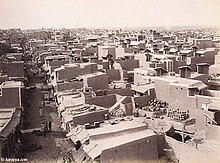
History
Main articles: History of Hyderabad, Pakistan and Old City (Hyderabad, Pakistan)
In AD 711, Muhammad bin Qasim conquered Sindh and the Indus Valley, bringing South Asian societies into contact with Islam. Raja Dahir was a Hindu king who ruled over a Buddhist majority and that Chach of Alor and his kin were regarded as usurpers of the earlier Buddhist Rai Dynasty.[3][4]This view is questioned by those who note the diffuse and blurred nature of Hindu and Buddhist practices in the region,[5] especially that of royalty to be patrons of both and those who believe that Chach himself may have been a Buddhist.[6][7] The forces of Muhammad bin Qasim defeated Raja Dahir in alliance with the Jats and other regional governors.
Hyderabad is a city built on three hillocks cascading over each other. Mian Ghulam Shah Kalhoro of the Kalhora Dynasty founded the city in 1768 over the ruins of Neroon Kot (Nerun or Nerun Kot meaning the place of Neroon), a small fishing village on the banks of Indus River named after its ruler Neroon. A formal concept for the city was laid out by his son, Sarfraz Khan in 1782. When the foundations were laid, the city obtained the nicknameHeart of the Mehran as the ruler Mian Ghulam Shah himself was said to have fallen in love with the city. In 1768 he ordered a fort to be built on one of the three hills of Hyderabad to house and defend his people. The fort was built using fire-baked bricks, on account of which it was named Pacco Qillo (Sindhi: پڪو قلعو) meaning the strong fort.[8]
The City has a history of Sufism. In the 18th Century Syeds from Multan migrated and settled at Tando Jahania making it a sacred place for Muslims. These Syeds came here from Uch Sharif (Bahawalpur District) via Jahanian (Khanewal District 42 km from Multan). These were the descendants of Jahaniyan Jahangashta noted Sufi saint.[9][10][11][12]
Capital of Sindh
The City of Hyderabad served as the capital of Sindh province, From 1947 to 1955, which was later dissolved and one unit was formed named West Pakistan.[13] The city also served as capital during Kalhoro regime
Demographics
The independence of Pakistan in 1947 saw the influx of Muslim Urdu-speakingMuhajirs from India fleeing from anti-Muslim pograms. Mahjirs mainly live in Latifabad and Sindhi mainly live in Qasimabad areas.
A large influx of Punjabis were attracted to Hyderabad after the Indus treaty settlement. Punjabis and Pakhtuns are distinct and live separately near the railway station and its vicinity.
Hindus account for the largest religious minority forming 5% of the total population of the city. While Christians account for 1% of the total population, Hyderabad is the seat of a Diocese of the Church of Pakistan and has five churches and a cathedral.
From Wikipedia, the free encyclopedia



No comments:
Post a Comment